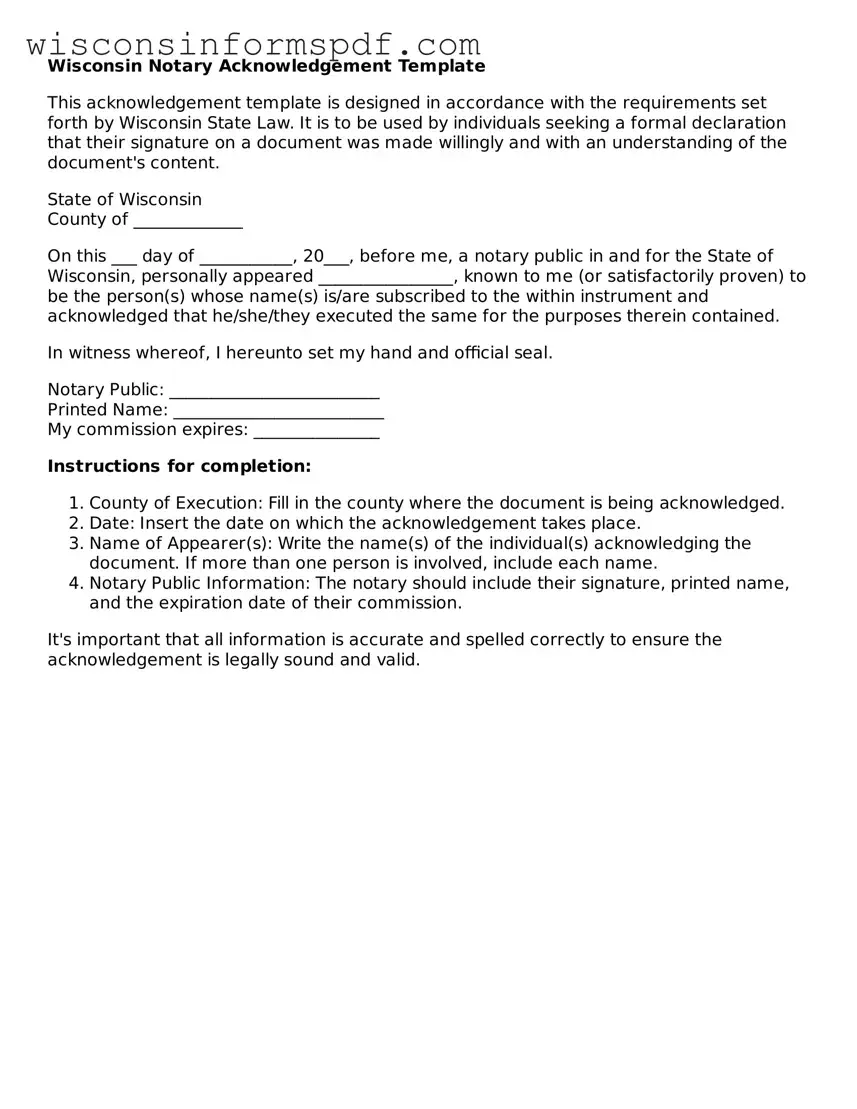The Wisconsin Notary Acknowledgment form shares similarities with the Jurat, which is another common notarial document. Both are pivotal in the authentication process of legal documents, but they serve different functions. The Notary Acknowledgement verifies the identity of the signer and confirms that the signature was made willingly and without duress, whereas the Jurat requires the signer to swear or affirm the contents of the document are true, often in the presence of the notary, adding an oath or affirmation to the signing process.
Comparable to the Wisconsin Notary Acknowledgment form, the Power of Attorney (POA) documentation also involves notarization to ensure its legitimacy and enforceability. A POA grants someone legal authority to act on another's behalf in specified matters. The involvement of a notary in both instances provides an official verification that the parties involved are who they claim to be, thereby securing the document's legal standing.
The Affidavit, similar to the Notary Acknowledgment form, is a sworn statement of fact that is voluntarily made by an affiant under an oath or affirmation administered by a person authorized to do so by law, like a notary public. Both documents necessitate the presence of a notary to verify the signer's identity and to formalize the signer's acknowledgment of the document's contents or the truth of the statements contained within.
The Deed of Trust is another legal document that, like the Notary Acknowledgment form, often requires notarization to be considered valid and enforceable. This document is used to secure a real estate transaction, wherein the borrower transfers the property title to a trustee until the loan is paid off. The notarization process authenticates the identities of the involved parties, similarly ensuring the document's authenticity and legal compliance.
Much like the Wisconsin Notary Acknowledgment form, the Last Will and Testament is a critical legal document that frequently requires notarization to affirm its validity. This document communicates a person's final wishes regarding their estate and the distribution of their assets upon death. Notarization in this context acts as a safeguard, verifying the identity of the document signer and confirming that the signature was made freely and with sound mind.
Closely related to the Notary Acknowledgment form is the Quitclaim Deed document, which is used to transfer property ownership without making any guarantees about the property's title. The role of notarization in both documents is essential for adding a layer of verification and protection, ensuring that the signees are who they claim to be and that their signatures are genuine.
The Mortgage Agreement, akin to the Notary Acknowledgment form, involves a legal process that typically requires notarization. This agreement secures a loan on real property by making it collateral against the debt. Notarization in both instances serves to authenticate the identities of the signatories and to formally witness the signing of the document, thereby reinforcing its validity and legal standing.
The Living Trust document, while serving a different purpose, similarly necessitates notarization like the Notary Acknowledgment form. This arrangement allows an individual to manage their assets during their lifetime and specify how these should be distributed upon their death. The notarization process confirms the identity of the person creating the trust (grantor), ensuring that the document's signing is executed properly and is legally binding.
Comparable to the Notary Acknowledgment form, the Consent Form, especially in legal contexts involving minors or medical decisions, often requires a notary's signature. This document signifies agreement to a proposed course of action or acknowledgment of risk, making notarization critical for validating the identity of the consenting party and affirming their understanding and agreement voluntarily and under no duress.
Lastly, the Bill of Sale document, which is used to transfer ownership of personal property from a seller to a buyer, shares similarities with the Notary Acknowledgment form. Both documents benefit from notarization as it provides an official means of verifying the involved parties' identities and signing intentions, thereby ensuring the document's integrity and legal effectiveness.
